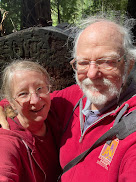Before I get into this week’s travels, I have a bit of housekeeping for Wanderlusting. Since early February, I have been attempting to chronicle our travels with this blog. I started by sharing how we found our way to the road and have shared many of our adventures. This blog, itself, is a journey, and I am learning a great deal through it, as well. Marlene does a great job by sharing daily updates on what we are doing and seeing with her FB posts that she shares on my page. If you read her posts, you will have a pretty good idea of what we have been up to. I sometimes do the check-ins, but Marlene is better able to get the pictures and updates out much quicker than I am.
Therefore, I will refocus Wanderlusting from being a chronicle of our adventures into a place where I will share pictures and stories you might be interested in seeing and reading. I want to respect your time and only share new pics and insights, so I will not repeat things we posted on FB. Each Sunday, I will review my week's pics and pick out a few for comment. I hope you find this new format more entertaining and enjoyable. Keep following us on FB. It is your seat for our journey. But each week, I hope to give you a little extra as we sit down and talk about our week together.
Enough of this tedious housekeeping, time to get on with the travels.
We started our week at Bandon / Port Orford KOA in Langlois, OR. This was a beautiful campground. It is an older campground, but the manager and staff are working very hard to make it an even better place to explore the Southern Oregon Coast. It sits between two very old fishing and shipping villages on striking headlands, Cape Blanco on the South and Coquille River Headlands on the North. Toward the end of our week, we moved on to Winchester Bay RV Resort in Winchester Bay, OR. This is a fishing, oystering, ATVing, and tourism village at the mouth of the Umpqua River. Here are a few of the things I found interesting along the way.

I found this tidal pool sitting about 10 feet above low tide at the foot of the Coquille Lighthouse. When I first saw it, I thought it was filled with tadpoles. They were darting and hiding in the small pool of seawater. But I had never heard of ocean frogs, so I thought I would look closer. It turns out that they were not tadpoles at all. They were baby fish stranded high above the surf by a low tide. After returning to Koko, a quick Google search said they were young Salmon. They were trapped in a tidal pool on their way to the Pacific. These tiny creatures have already run the gauntlet of freshwater streams in the mountains. And just as they were at the edge of freedom in the Pacific, a wave dropped them on this reef. They must now wait for another wave to come along and liberate them for the new life in the open ocean. They will return in a few years, but until then, this little pond may be the last time they see another Salmon and until their childhood home to spawn and die in these same waters. Life is quite fragile on these rocky shores. But its fragility increases my respect for it and the creative ways that it finds to survive and thrive in a world filled with giant waves and small tidal pools of experience.










Welcome to the adventure,
Bob.

















Interesting read. I liked the comments about the salmon fry.
ReplyDelete